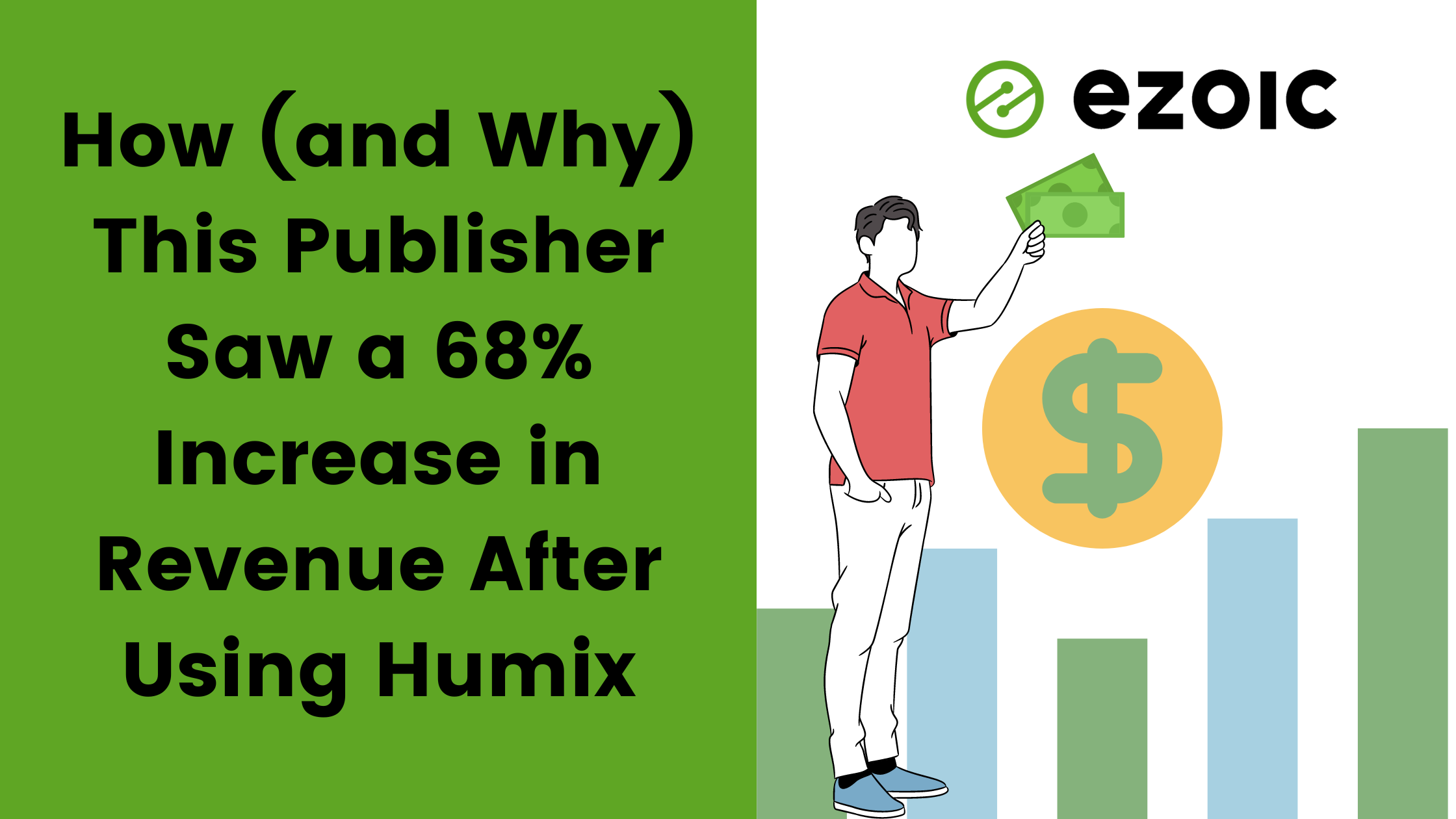
How (and Why) This Publisher Saw a 68% Increase in Revenue After Using Humix

Get helpful updates in your inbox
The two issues on every publisher’s mind, either consciously or unconsciously, usually revolve around these eternal questions:
- How can I earn more revenue?
- How can I get more traffic?
Most of our work can (and probably should) relate to answering these questions. The art of publishing comes from applying strategies and executing ideas that tend to bring us more traffic and, therefore, more revenue. Anyone can buy a domain and publish a few blog posts; it’s difficult to actually earn money — real money — and see a real increase in revenue in the process.
This can be a hard issue, especially at the beginning. Markets change, algorithms evolve, trends come and go. What worked last year, even last month, might not work today. It’s difficult to know what strategies to employ.
That’s why Ezoic always wants to bring up evergreen, lasting strategies that will help you grow your site no matter when you read this. Today, we’re going to look at the power of video content, and how integrating video into your site can be so beneficial for both your traffic and revenue.

“This is How It’s Always Been Done”
For many years, the most popular and accepted video strategy revolved around YouTube. It’s no surprise; it’s the most popular search engine in the world.
For publishers, it presented a two-fold problem: first, they needed to create their own videos and become full-time video creators if they ever wanted to earn any money. Second, there was a high barrier of entry, where you’d only get paid if you reached over 1,000 subscribers and gained over 4,000 hours of public watch time, among other requirements — a feat only around 0.25% of YouTube channels have ever accomplished!
As a result, YouTube’s financial viability was limited, especially for publishers who weren’t comfortable on camera or didn’t have the resources to record and edit their own videos.
Still, the mindset of “this is how it’s always been done” became a prevailing factor many publishers believed about using YouTube for video.
When Ezoic launched Humix, our versatile video network and video toolkit, we did it with publishers in mind; if publishers could use Humix effectively, their traffic and revenue could increase tremendously.
Which is exactly what happened with this publisher below. Let’s break down some of the most notable metrics from this experiment.
How This Publisher Saw a 68% in Revenue After Switching From YouTube to Humix
Countless Ezoic publishers have begun earning significant revenue after using Humix, but let’s look at one publisher in particular, which can reveal some key insights into the video tool.
The line here shows when this publisher enabled Humix on their site. There are few things to notice here. First, as you can see, both the First Input Delay (FID) and the Cumulative Layout Shift (CLS) improved, by 36% and 25% respectively, which means the on-page videos loaded quickly and smoothly:
Next, there was a decent bounce rate improvement by about 4%. Bounce rate is notoriously difficult to track and analyze, but there are several reasons why enabling Humix videos specifically can help with this metric: Humix has custom video borders and features that can better align with your site, which makes videos look more natural and thus increasing page engagement, etc.
Finally, we see some eye-popping metrics, like a massive 68% increase in overall revenue. As you can see, traffic and revenue are both positively impacted through using Humix.
In this particular case, this publisher was creating content based around a big event in their niche, capitalizing on the traffic spike. They had turned on Humix’s “auto engage and earn” feature, meaning they hadn’t even created any videos of their own but were instead allowing other Humix videos to be displayed on their site, which helped them earn enormous revenue during this seasonal traffic spike.
When it comes to your niche, turning on Humix videos (or using Flickify to turn your articles into Humix videos) can earn significant revenue if they’re strategically based around events, seasonal spikes, or trends that naturally attract bigger and more engaged audiences.
Basic and Advanced Strategies for Integrating Video
Thanks to Flickify, you can begin converting your articles into videos today in a matter of minutes. Thanks to Humix, you can then upload these videos to begin earning display revenue.
For starters, you can simply use older top-performing articles you’ve published in the past to convert into high-quality video versions. These articles performed well for a reason, and you can use them to not only get familiar with the Flickify tool, but also give yourself a strong position to start getting video views from your most popular articles.
Best of all, by doing this you’re getting indexed by the second largest search engine in the world: Google Images and Videos. This will help you get more traffic, greatly helped by the fact that there is far less competition in this search engine than regular Google Search.
Another more advanced strategy is targeting pages and articles you’ve published that do not have any video content on them, and inserting your videos into these pages. There may be a glut of written content for that page’s particular keywords or metadata, but there may not be nearly as much video content competition. You can capitalize on this by giving your content a chance to reach an entirely new audience.
Strong SEO will benefit videos as well as written content, and you can customize your SEO within the Humix dashboard to ensure you’re increasing your chances of getting indexed as much as possible.

In Conclusion
In the words of Wordstream research: “It’s often easier to drive traffic through image search or video search than plain old regular search — in part because there’s less competition and in part because the competition is less likely to be properly optimized. So think of image search as an easy win.”
Every day, publishers work incredibly hard to get traffic, retain subscribers, and earn more revenue. They’re constantly posting content, answering emails, updating social media, fixing site bugs, and more.
You can (and should) always try to optimize your content (Ezoic is an enormous help with this, especially through tools like NicheIQ, our SEO toolkit). But if you’re not using video for your site, or are barely using it, taking advantage of tools like Flickify and Humix can garner enormous traffic and revenue if used properly.
This can take an enormous load off your plate, as well as place yourself in a unique position to:
- Create video content (and thus serving more of your video-preferring audience)
- Display others’ high-quality videos on your site, which helps increase time-on-page, pageviews, and overall revenue
- Garner more traffic through Google Images and Video, a search engine with inherently less competition and more opportunity
At the peak of my publishing success, my main strategy revolved around “working harder.” Instead of posting 2–3 high-quality articles a week, I’d post 4–5. I’d try to answer every email. I’d conduct more SEO research. But in the end, my energy plummeted and my views dropped.
Using Flickify and Humix can serve as a massive relief for you, and an enormous benefit for your business. How would you feel if you also saw a 68% revenue increase like the publisher above? How would you feel if you had more breathing room, more money, and more options?
How would you feel if you knew you could tap into this resource right now?
You can integrate Humix today. Click here for non-Ezoic publishers, and click here for Ezoic publishers!

Anthony Moore is a writer, speaker, and coach. He's helped hundreds of entrepreneurs create successful businesses, and has gained over 7 million views for his work on entrepreneurship, personal growth, and productivity.
Featured Content
Checkout this popular and trending content

Ranking In Universal Search Results: Video Is The Secret
See how Flickify can become the ultimate SEO hack for sites missing out on rankings because of a lack of video.
Announcement

Ezoic Edge: The Fastest Way To Load Pages. Period.
Ezoic announces an industry-first edge content delivery network for websites and creators; bringing the fastest pages on the web to Ezoic publishers.
Launch

Ezoic Unveils New Enterprise Program: Empowering Creators to Scale and Succeed
Ezoic recently announced a higher level designed for publishers that have reached that ultimate stage of growth. See what it means for Ezoic users.
Announcement
